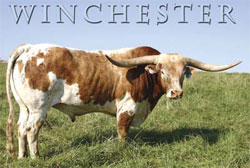|
|
| History of the Texas Longhorn |
 The Texas Longhorn became he foundation af the American cattle industry
by claiming first rights in the untamed, newly discovered Americas a
little over 500 years ago. In 1493, Christopher Columbus brought Spanish
cattle to Santa Domingo, and within two hundred years their descendents
would be grazing the ranges of Mexico. The Texas Longhorn became he foundation af the American cattle industry
by claiming first rights in the untamed, newly discovered Americas a
little over 500 years ago. In 1493, Christopher Columbus brought Spanish
cattle to Santa Domingo, and within two hundred years their descendents
would be grazing the ranges of Mexico.
In 1690, the first herd of cattle, only about 200 head, was driven
northward from Mexico to a mission near the Sabine River - a land that
would become known as Texas. The early missions and ranchers would not
survive all os the elements. But the Texas Longhorn would.
 By the time of the Civil War, nearly 300 years after setting foot in
America, millions of Longhorns ranged between the mesquite-dotted sandy
banks of the Rio Bravo to the sand beds of the Sabine. Most of the
Longhorns were unbranded, survivors of Indian raids, scattered by
stampedes and weather, escaped from missions or abandoned after ranch
failures. By the time of the Civil War, nearly 300 years after setting foot in
America, millions of Longhorns ranged between the mesquite-dotted sandy
banks of the Rio Bravo to the sand beds of the Sabine. Most of the
Longhorns were unbranded, survivors of Indian raids, scattered by
stampedes and weather, escaped from missions or abandoned after ranch
failures.
The survivors of the Civil War returned home to Texas fo find abandoned
ranches, unplowed farmfields and herds of wild cattle, which would soon
become gold i their pockets. In the next quater century, 10 million head
were trailed north to fatten on lush mid-western grasses or shipped
direcly by rail to the beef-hungry East.
Translating wild cattle into hard cash was an epic struggle between man,
beast and the elements - from this grew the romantic legends of the
Western Cowboy.
Longhorns, groomed by Mother Nature, carried the ideal characteristics
of resistance - they were tremendous for long drives. They could go
incredible distances without water, rustle their own food, fend for
themselves, swim rivers, and survive the desert sun og winther snow.
But, at the turn of the century, sundown came for the Texas Longhorn. It
took less than 40 years, fenced in land, plows and an overwhelming
demand in the marketplace to drive the Longhorn closer to extinction
than the buffalo.
In 1927, the federal government helped to preserve the Texas Longhorn
and a great part of our American heritage. With only a handful of Texas
Longhorns roaming the ranges in private herds, Congress appropriated
$3,000, and assigned forest service vice rangers, Will C. Barns and John
H. Hatton to the task.
These two men put the first herd together for Wichita Mountains Wildlife
Refuge in Oklahoma. Another herd was established on the Fort Niobrara
National Wildlife Refuge at Valentine, Nebraska. Also, at this time, the
early 30s, the State of Texas formed its own herd with the help of J.
Frank Dobie, author of The Longhorns, and his friend Graves Peeler, who
had excellent knowledge of the Texas range country.
Gradually, more breeders started raising private stock, recognizing the
value of Texas Longhorns. The need grew for breed standards and a direct
line of communication between the Longhorn breeders.
I 1964, the Texas Longhorn Breeders Association of America was formed i
Lawton, Oklahoma. At this time there were less than 1,500 head of
genuine Texas Longhorn cattle in existence - a third in the Federal
refuges, the State og Texas herd, zoos, parks and other private herds.
The purpose of the Association was to recognize the Texas Longhorn and
its link with American history, to promote awareness of Texas Longhorn
cattle, to recognize present breeders, to encourage others to develop
and maintain herds and to preserve for posterity this magnificent breed
of cattle.
|
|
|